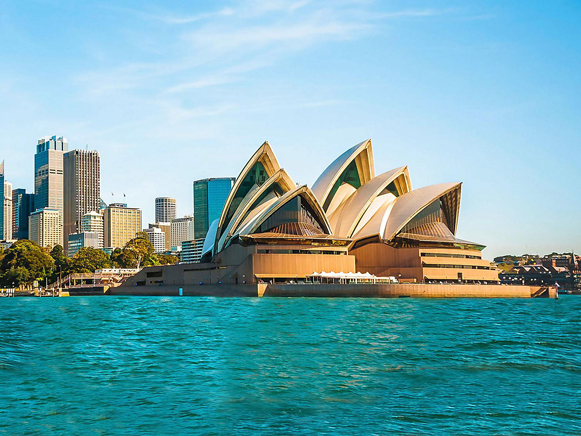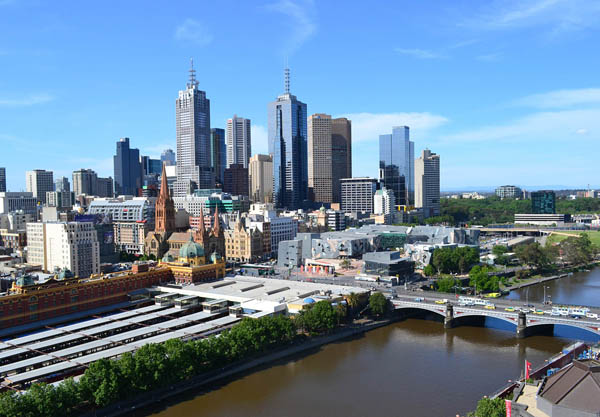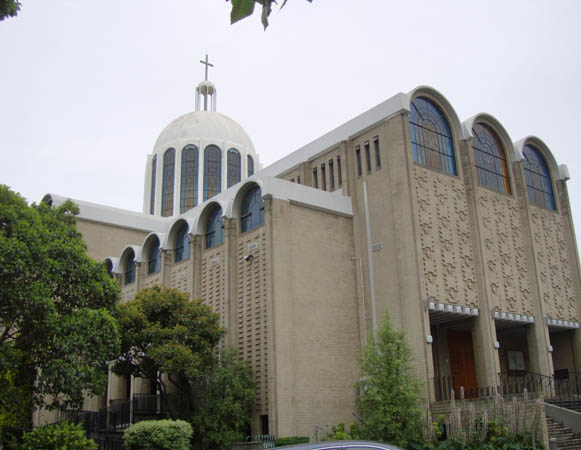Australia
Australia. Commonwealth of six federated states covering the Australian continent, Tasmania, and some small islands of the Indian and Pacific oceans. Its area is 7,692,024 sq km; in 2021 Australia had a population of 25,838,100, including over 30,000 Ukrainians.
History of Ukrainian settlement. Only a few Ukrainians are known to have lived in Australia before the Second World War. Most came via the Far East or China. According to an agreement with the International Refugee Organization (IRO), Australia admitted a certain number of war refugees and displaced persons from western and southern Europe, Asia, and Africa. In 1948–51 about 21,500 Ukrainians emigrated to Australia. The immigrants were obliged to work for two years at locations assigned by the government. After a short stay at transfer camps they were dispersed in small groups throughout Australia to meet the postwar demand for unskilled labor. Work was assigned without regard for the immigrant’s general education or professional training. It was forbidden to change residence or work on one’s own. After two years immigrants automatically received the right of permanent residency and the right to choose their work. After five years they became eligible for Australian citizenship. Upon fulfilling their contracts, most immigrants moved to the large cities where they could find better jobs in industry and could participate in Ukrainian community life. In later years few Ukrainians emigrated to Australia; those who did were mainly from England, Yugoslavia, and the Far East. The number of Ukrainian immigrants entering Australia was practically equal to the number leaving: 346 people entered, and 498 left in 1952–61.
Demographic data. Many Ukrainians in Australia were assigned to other national groups (Russian, Polish, German, etc) in the official statistics because of their place of birth or citizenship. Hence, the number of early settlers that is given above should be increased by 10–20 percent. Because of very low mortality and a high birth rate (over 4 percent per year in the first few years), the number of Ukrainians grew rapidly. The precise figure could not be established for many years because there were many mixed marriages and because, in the official statistics, new births were counted as Australian. A 1965 estimate by the Australian Federation of Ukrainian Organisations (AFUO) put the number of Ukrainians in the country at approximately 37,500. The 1986 Australian census provided—for the first time—a direct question about ethnic origin. A total of 28,885 people indicated their ancestry as Ukrainian; the number increases to 32,065 after factoring in the proportion of individuals (6.8 percent) who had not responded to the census question. An estimation by Eugene Seneta put the number at approximately 34,000 in 1994. According to the 1986 census, the distribution of Ukrainians was the following (1961 percentages in parentheses): New South Wales (NSW), 31.22 percent (34.8); Victoria, 33.6 percent (32.6); South Australia (SA), 15.6 percent (16.7); Western Australia, 7.2 percent (7.3); Queensland, 8.3 percent (5.8); Tasmania, 1.5 percent (1.5); Australian Capital Territory, 2.4 percent (1.5) percent. About 75 percent of the Ukrainians lived in state capitals, 22 percent in provincial cities and towns, and 3 percent on farms. According to the Federation of Ukrainian Organisations 1965 figures the number of Ukrainians living in state capitals was approximately as follows: Sydney, 10,000; Melbourne, 9,000; Adelaide, 5,800; Perth, 1,600; Brisbane, 1,500. In the first immigration men outnumbered women six to four. For this and other reasons there were many more mixed marriages than endogamous marriages. Marriages of the second generation follow a similar pattern.
Social and political life. Ukrainians are one of the best-organized ethnic groups in Australia. As early as the beginning of 1949 they began to form non-political civic associations in areas of Ukrainian concentration. The purpose of these organizations was to represent the Ukrainian community in a given locality, to organize its cultural life, to provide aid to members, and so on. In time these organizations acquired their own buildings, usually with concert halls, where most Ukrainian cultural, political, and academic events take place today. In 1950 a congress of representatives from Ukrainian state associations and national organizations set up a federal umbrella organization called the Union of Ukrainians in Australia to coordinate activities and to represent Ukrainians at the federal level. In 1953 the union became the AFUO. Its leaders are elected every three years (to 1989, every two years) by a general congress. Since 1949 a number of social, political, sports, and youth associations of a local or national character have also been established. The Ukrainian Women's Association in Australia (est 1949) has 16 branches and about 700 members. It publishes the quarterly Nashe slovo. There are two youth organizations—Plast Ukrainian Youth Association and the Ukrainian Youth Association—each with about 800 members and its own camping grounds in NSW, Victoria, and SA. For veterans there is a general organization—the Union of Ukrainian Veterans—and two narrower organizations—the Brotherhood of Former Soldiers of the First Ukrainian Division of the Ukrainian National Army and the Symon Petliura Legion. Sports clubs exist in the larger cities. Several political parties and organizations have branches in Australia. Most active among them is the OUN (Bandera faction) and (formerly) the Ukrainian Anti-Bolshevik League (known until 1965 as the Ukrainian Delegation of the Anti-Bolshevik Bloc of Nations). Among less-active organizations are the Ukrainian Revolutionary Democratic party and the United Hetman Organization. The Ukrainian National Council was represented in Australia by a national office of its executive body and supported by the Society of Friends of the Ukrainian National Council.
Religious life. According to the 1986 census, 50.5 percent of the Ukrainians were Catholic, 34.3 percent were Orthodox, and 7 percent belonged to other faiths. The well-organized Ukrainian Catholic church was initially under the jurisdiction of the Australian Roman Catholic church. On 19 May 1958, by papal decree, a separate apostolic exarchate for Ukrainians in Australia and New Zealand was established. It was responsible directly to the apostolic see and was headed by Bishop Ivan Prashko. In 1982 the exarchate was raised to the status of an eparchy. In 1994 the Ukrainian Catholic church had 8 parishes with 14 churches as well as 3 convents. Church organizations and brotherhoods are consolidated in the Alliance of Ukrainian Catholic Organizations in Australia. The church’s publishing house, Prosvita, issues a weekly newspaper of general interest, Tserkva i zhyttia. The larger parishes publish their own church bulletins.
The Orthodox church underwent a series of changes and jurisdictional splits. In 1978 it divided into two churches with about the same number of members: the Ukrainian Autocephalous Orthodox church, headed at that time by Metropolitan Mstyslav Skrypnyk of the United States; and the Ukrainian Orthodox Church of Canada, headed then by Metropolitan Andrei Metiuk of Canada. Each church had its own parishes, consistory, and administration. Owing to the deaths of local bishops—I. Danyliuk, Varlaam Solovii, Sylvestr Haievsky and D. Burtan—the church had no episcopate of its own. Altogether there were 17 parishes and as many churches, 16 priests, and 4 deacons. In 1992 the Orthodox church factions resolved their differences and reunited.
Ukrainians of other faiths (Baptists, Lutherans, Pentecostals, etc) so far do not have their own national organizations, although there have been some efforts to create them.
Education and cultural life. The government has not hindered the development of Ukrainian life and ethnic culture. It has even encouraged such development within the framework of the policy of multiculturalism. For this reason Ukrainians were able very quickly to establish schools and organize social, artistic, and scholarly activities. In early 1950 various associations, churches, and the women’s organizations established a number of Saturday schools to teach the Ukrainian language and provide some general knowledge about Ukraine. In 1952 school councils for the states of Victoria and NSW were set up to co-ordinate education in these states. The first national teachers’ convention (1956 in Melbourne) established the Ukrainian Council of Education in Australia, which oversees education in Ukrainian schools throughout Australia. Its officers and head-office location (Melbourne and Adelaide until now) are selected every three years. Parents’ committees supervise individual schools. The basic seven-year program is limited to religion, Ukrainian language, history of Ukraine, and geography. Larger schools provide day-care centers, preschool classes, one- and two- year teacher’s training, and exam-preparation courses for matriculating students. The number of schools, students, and teachers has fluctuated, reaching a peak in 1959 (39 schools, 2,072 students) and then gradually declining. In 1997 there were 12 schools, 79 teachers, and 450 students. Dance groups, choirs, and reading circles also exist at the schools. There are no Ukrainian-language courses in public high schools, although Ukrainian is recognized as a matriculation credit in certain states.
In 1983 the Mykola Zerov Lectureship in Ukrainian (headed by Marko Pavlyshyn) was established at Monash University in Clayton, near Melbourne. In 1984 the Ukrainian Studies Centre was established at Macquarie University in Sydney, owing to the efforts of the Ukrainian Studies Foundation in Australia (est 1974).
There are amateur theater groups and drama circles, usually attached to associations. Among the best choirs are Boian in Sydney, Chaika in Melbourne, Homin in Adelaide, and the Ukrainian Catholic Cathedral Youth Choir in Melbourne. There are also some good smaller choirs supported by various organizations. Ye. Pavlovska, T. Taras, H. Korin, V. Matiiash, and Ya. Lishchynsky are well-known singers, and K. Skrypchenko, A. Miroshnyk, and O. Tarnavska are prominent pianists. Every large Ukrainian community has a dance group.
Literary-artistic circles and clubs are found in Sydney, Melbourne, and Adelaide. Among the most productive writers and poets were Mykola Lazorsky, Dmytro Nytchenko, V. Onufriienko, and P. Vakulenko. The best-known painters have been Mykhailo Kmit, Volodymyr Savchak, L. Denysenko, V. Tsybulsky, M. Chornii (Chorney), and T. Messak.
Ukrainian scholars are organized in the Australian branch of the Shevchenko Scientific Society, with centers in Sydney, Melbourne, and Adelaide. The branch has been headed by Yevhen Yulii Pelensky, Pavlo Shulezhko, Ivan Rybchyn, T. Liakhovych, I. Vashchyshyn, Roman Mykytovych, and Marko Pavlyshyn. Ukrainian engineers belong to the Ukrainian Society of Professional Engineers in Australia (est 1954), and Ukrainian physicians belong to the Ukrainian Medical Association (est 1976). Ukrainian-Australian Graduates Associations have been established in NSW (1978) and SA (1979).
Press. The first Ukrainian newspapers—Vil’na dumka in Sydney and Iednist' in Adelaide—began publication in 1949. In 1956 Ukraïnets’ v Avstraliï and in 1960 Tserkva i zhyttia appeared in Melbourne. All published weekly with a circulation of 1,500–2,000; Iednist' and Ukraïnets' v Avstraliï have since folded. Among book publishers the best known has been the Mykola Zerov Society of Australia, established in 1955 in Adelaide. Works by local Ukrainian writers have been published in Australia and in other countries.
Economic life. In spite of the peasant origin of most Ukrainian immigrants, according to the 1961 census only 2 percent of them worked on farms. Fifty percent worked in industry (mostly in unskilled or semiskilled jobs). The rest worked in transportation, commerce, administration, etc. Among professional groups the European degrees only of engineers, architects, and teachers were recognized. Physicians and lawyers were required to complete long internship training. Most of them took jobs outside their profession or else emigrated. In recent years many young people have been completing higher education and are strengthening the professional ranks of the Ukrainian community.
The Ukrainians in Australia have attained a relatively high standard of living. A number of credit co-operatives have been established to render material help: Dnister, Odesa, and Postup in Melbourne; Dnipro and Karpaty in Sydney; Hoverla in Adelaide; and Kalyna in Perth. Since 1973 they have been united in the Council of Ukrainian Credit Co-operatives in Australia; the capital controlled by the member groups was approx A$60 million by the 1990s.
Developments in the 1990s. The split between the two branches of the Ukrainian Orthodox church was resolved, and since 1992 they have constituted a united Australian and New Zealand Orthodox church. Earlier Volodymyr Didovych served as bishop of the Ukrainian Autocephalous Orthodox church until his death in 1990, at which time the church came under the jurisdiction of Patriarch Mstyslav Skrypnyk. The Ukrainian Orthodox church was administered by Archpresbyter Borys Stasyshyn. The Ukrainian Catholic bishop, Ivan Prashko, retired in 1993 and Peter Stasiuk assumed his position as bishop for Ukrainian Catholics in Australia, New Zealand, and Oceania. The Ukrainian Evangelical Baptist Convention in Australia (est 1960) continues to unite its member congregations in Sydney, Melbourne, Brisbane, and Perth, but not the Ukrainian Evangelical Baptist church in Melbourne (which never joined the association).
The Ukrainian Studies Association of Australia was established in 1990 to foster links with Ukrainian scholarship worldwide. As well, the study of Ukrainians in Australia expanded through the 1980s, as evidenced by the staging of five conferences on Ukrainian settlement in Australia from 1983 to 1990.
BIBLIOGRAPHY
Ukraïntsi v Avstraliï: Materiialy do istoriï poselennia ukraïntsiv v Avstraliï (Melbourne 1966)
Volovyna, O.; Hordiïv, I.; Hordiïv, L. ‘Ukraïntsi v Avstraliï,’ in Ukraïns'ki poselennia: Dovidnyk, ed A. Milianych et al (New York 1980)
Pavlyshyn, M. (ed). Ukrainian Settlement in Australia: Second Conference, Melbourne, 5–7 April 1985 (Melbourne 1985)
Gordijew, I.; Koscharsky, H. (eds). Ukrainian Settlement in Australia: Fourth Conference, Sydney, 22–24 April 1988 (Sydney 1988)
Pavlyshyn, M. (ed). Ukrainian Settlement in Australia: Fifth Conference, Melbourne, 16–18 February 1990 (Melbourne 1993)
Al'manakh ukraïns'koho zhyttia v Avstraliï (Sydney 1994)
Markus', V.; Pavlyshyn, M.; Troshchyns'kyi, V. ( eds). Entsyklopediia ukraïns'koii diiaspory. Vol 4. Avstraliia—Aziia—Afryka (Kyiv 1995)
Pavlyshyn, M. et al (eds). Ukraïntsi v Avstraliï, vol 2 (Melbourne 1998)
Roman Olesnytsky
[This article was updated in 1995.]



